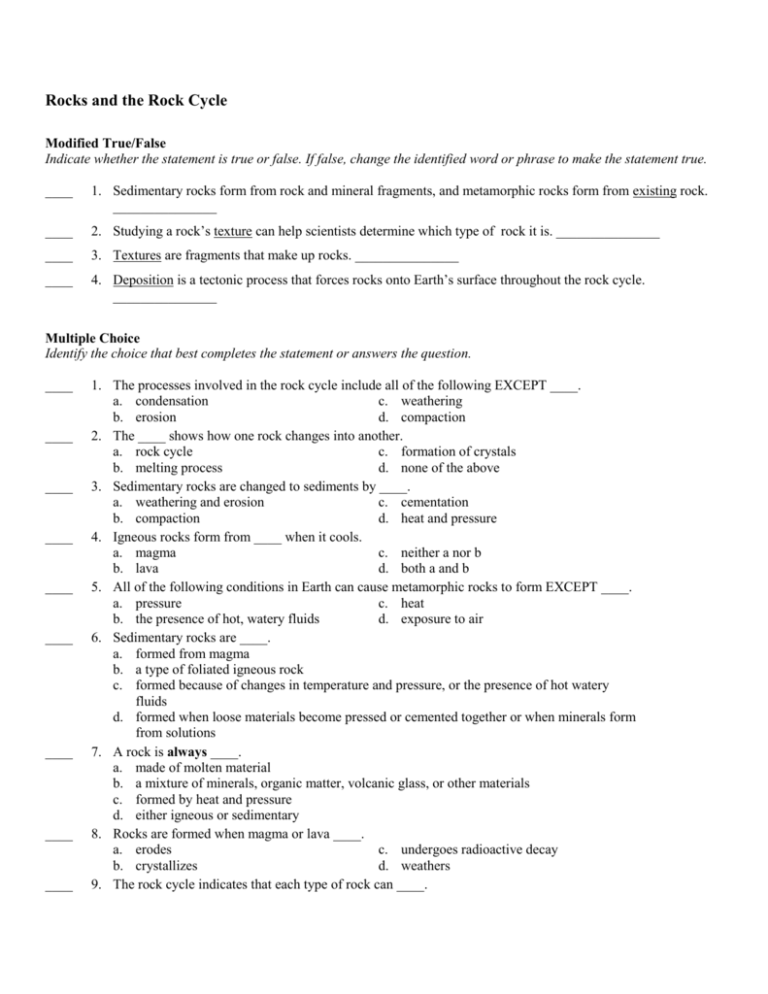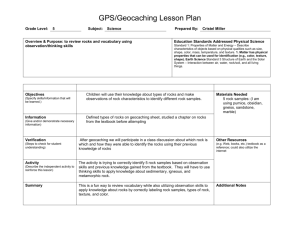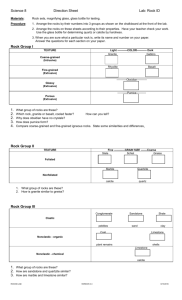Rocks and the Rock Cycle
advertisement

Rocks and the Rock Cycle Modified True/False Indicate whether the statement is true or false. If false, change the identified word or phrase to make the statement true. ____ 1. Sedimentary rocks form from rock and mineral fragments, and metamorphic rocks form from existing rock. _______________ ____ 2. Studying a rock’s texture can help scientists determine which type of rock it is. _______________ ____ 3. Textures are fragments that make up rocks. _______________ ____ 4. Deposition is a tectonic process that forces rocks onto Earth’s surface throughout the rock cycle. _______________ Multiple Choice Identify the choice that best completes the statement or answers the question. ____ ____ ____ ____ ____ ____ ____ ____ ____ 1. The processes involved in the rock cycle include all of the following EXCEPT ____. a. condensation c. weathering b. erosion d. compaction 2. The ____ shows how one rock changes into another. a. rock cycle c. formation of crystals b. melting process d. none of the above 3. Sedimentary rocks are changed to sediments by ____. a. weathering and erosion c. cementation b. compaction d. heat and pressure 4. Igneous rocks form from ____ when it cools. a. magma c. neither a nor b b. lava d. both a and b 5. All of the following conditions in Earth can cause metamorphic rocks to form EXCEPT ____. a. pressure c. heat b. the presence of hot, watery fluids d. exposure to air 6. Sedimentary rocks are ____. a. formed from magma b. a type of foliated igneous rock c. formed because of changes in temperature and pressure, or the presence of hot watery fluids d. formed when loose materials become pressed or cemented together or when minerals form from solutions 7. A rock is always ____. a. made of molten material b. a mixture of minerals, organic matter, volcanic glass, or other materials c. formed by heat and pressure d. either igneous or sedimentary 8. Rocks are formed when magma or lava ____. a. erodes c. undergoes radioactive decay b. crystallizes d. weathers 9. The rock cycle indicates that each type of rock can ____. a. provide materials to make other rocks b. form other rocks c. be changed by forces at Earth's surface d. all of the above ____ 10. Which type of scientist analyzes the composition of rocks? a. an environmentalist c. a biologist b. a naturalist d. a geologist ____ 11. Which is a tectonic process that forces rocks up from beneath Earth’s surface? a. melting c. deposition b. uplift d. crystallization ____ 12. Rocks can change throughout many different processes through the rock cycle. All of the following change rocks on Earth’s surface except _____. a. weathering c. deposition b. melting d. compaction Completion Complete each statement. 1. Rock formed from the crystallization of magma is called _________________________. 2. A natural, solid mixture of minerals or grains is called a ______________. 3. The three basic types of rocks are igneous, _______________________, and metamorphic. 4. Sedimentary rocks are formed when ______________ is deposited in environments like rivers and streams. Matching Match the tectonic force that best explains how each type of rock is formed. a. extreme temperature and pressure b. melting c. uplift d. weathering and erosion ____ ____ ____ ____ 1. 2. 3. 4. igneous rock to sedimentary rock metamorphic rock to igneous rock sedimentary rock to metamorphic rock metamorphic rock to sedimentary rock Short Answer Use this rock cycle model to answer the three questions below. Each answer is worth 2 points. 1. According to this rock cycle model, can a sedimentary rock be transformed directly into an igneous rock? Why or why not? ________________________________________________________________________________________ ________________________________________________________________________________________ ________________________________________________________________________________________ ________________________________________________________________________________________ ________________________________________________________________________________________ ____________________________________________________________________________________ 2. Discuss how a metamorphic rock could become a sedimentary rock. ________________________________________________________________________________________ ________________________________________________________________________________________ ________________________________________________________________________________________ ________________________________________________________________________________________ ________________________________________________________________________________________ 3. Explain the difference between the rectangles and the ovals in this model. ________________________________________________________________________________________ ________________________________________________________________________________________ ________________________________________________________________________________________ _________________________________________________________________________________ Rocks and the Rock Cycle Answer Section MODIFIED TRUE/FALSE 1. ANS: REF: STA: 2. ANS: REF: 3. ANS: T PTS: 1 To review this topic refer to Rocks: Lesson 1 5.4.6.C.2 T PTS: 1 To review this topic refer to Rocks: Lesson 2 F, Grains PTS: REF: STA: 4. ANS: 1 DIF: Bloom's Level 2 | DOK 1-LOW To review this topic refer to Rocks: Lesson 1 5.4.6.C.2 F, Uplift PTS: 1 DIF: Bloom's Level 2 | DOK 1-LOW REF: To review this topic refer to Rocks: Lesson 1 STA: 5.4.6.C.2 | 5.4.6.C.3 DIF: Bloom's Level 1 | DOK 1-LOW OBJ: 4-1 DIF: Bloom's Level 2 | DOK 1-LOW OBJ: 4-3 OBJ: 4-1 OBJ: 4-2 MULTIPLE CHOICE 1. ANS: A The series of processes that change one type of rock into another type of rock is called the rock cycle. PTS: 1 DIF: Bloom's Level 1 | DOK 1-LOW REF: To review this topic refer to Rocks: Lesson 1 OBJ: 4-2 STA: 5.4.6.C.2 2. ANS: A The series of processes that change one type of rock into another type of rock is called the rock cycle. PTS: 1 DIF: Bloom's Level 1 | DOK 1-LOW REF: To review this topic refer to Rocks: Lesson 1 OBJ: 4-2 STA: 5.4.6.C.2 3. ANS: A Forces such as wind, running water, ice, and even gravity cause rocks on Earth’s surface to break down. PTS: 1 DIF: Bloom's Level 1 | DOK 1-LOW REF: To review this topic refer to Rocks: Lesson 1 OBJ: 4-2 STA: 5.4.6.C.2 4. ANS: D When lava cools and crystallizes, it becomes igneous rock. | Igneous rocks that form as magma cools underground are called intrusive rocks. PTS: 1 DIF: Bloom's Level 1 | DOK 1-LOW REF: To review this topic refer to Rocks: Lesson 2 STA: 5.4.6.C.2 | 5.4.8.D.1 OBJ: 4-3 5. ANS: D Changes in temperature, pressure, or the addition of chemical fluids can result in the rearrangement of minerals or the formation of new minerals in a metamorphic rock. PTS: 1 DIF: Bloom's Level 1 | DOK 1-LOW REF: To review this topic refer to Rocks: Lesson 4 OBJ: 4-7 STA: 5.4.6.C.2 6. ANS: D After sediments are deposited, the process of compaction and cementation begins. PTS: 1 DIF: Bloom's Level 1 | DOK 1-LOW REF: To review this topic refer to Rocks: Lesson 3 STA: 5.4.6.C.2 7. ANS: B A rock is a natural, solid mixture of minerals or grains. PTS: 1 DIF: Bloom's Level 1 | DOK 1-LOW REF: To review this topic refer to Rocks: Lesson 1 STA: 5.4.6.C.2 8. ANS: B When lava cools and crystallizes, it becomes igneous rock. OBJ: 4-5 OBJ: 4-1 PTS: 1 DIF: Bloom's Level 2 | DOK 2-MOD REF: To review this topic refer to Rocks: Lesson 2 OBJ: 4-3 STA: 5.4.6.C.2 | 5.4.8.D.1 9. ANS: D The series of processes that change one type of rock into another type of rock is called the rock cycle. PTS: 1 DIF: Bloom's Level 1 | DOK 1-LOW REF: To review this topic refer to Rocks: Lesson 1 STA: 5.4.6.C.2 10. ANS: D Geologists use texture and composition to classify rocks. OBJ: 4-2 PTS: 1 DIF: Bloom's Level 2 | DOK 1-LOW REF: To review this topic refer to Rocks: Lesson 1 OBJ: 4-1 STA: 5.4.6.C.2 | 5.4.8.D.1 11. ANS: B Uplift is a tectonic process that forces these rocks onto Earth’s surface. PTS: 1 DIF: Bloom's Level 1 | DOK 1-LOW REF: To review this topic refer to Rocks: Lesson 1 OBJ: 4-2 STA: 5.4.6.C.2 | 5.4.8.D.1 12. ANS: B Some rock cycle processes occur only beneath Earth’s surface, such as those that involve extreme temperature, pressure, and melting. PTS: 1 DIF: Bloom's Level 2 | DOK 1-LOW REF: To review this topic refer to Rocks: Lesson 1 STA: 5.4.6.C.2 | 5.4.6.C.3 OBJ: 4-2 COMPLETION 1. ANS: igneous rock PTS: REF: STA: 2. ANS: 1 DIF: Bloom's Level 2 | DOK 2-MOD To review this topic refer to Rocks: Lesson 1 5.4.6.C.2 rock PTS: REF: STA: 3. ANS: 1 DIF: Bloom's Level 1 | DOK 1-LOW To review this topic refer to Rocks: Lesson 1 5.4.6.C.2 sedimentary PTS: REF: STA: 4. ANS: 1 DIF: Bloom's Level 2 | DOK 1-LOW To review this topic refer to Rocks: Lesson 1 5.4.6.C.2 sediment PTS: 1 DIF: Bloom's Level 2 | DOK 1-LOW REF: To review this topic refer to Rocks: Lesson 1 STA: 5.4.6.C.2 OBJ: 4-1 OBJ: 4-1 OBJ: 4-1 OBJ: 4-1 MATCHING 1. ANS: REF: STA: 2. ANS: REF: STA: 3. ANS: REF: STA: 4. ANS: REF: STA: D PTS: 1 DIF: Bloom's Level 3 | DOK 2-MOD To review this topic refer to Rocks: Lesson 1 OBJ: 4-2 5.4.6.C.2 B PTS: 1 DIF: Bloom's Level 3 | DOK 2-MOD To review this topic refer to Rocks: Lesson 1 OBJ: 4-2 5.4.6.C.2 A PTS: 1 DIF: Bloom's Level 3 | DOK 2-MOD To review this topic refer to Rocks: Lesson 1 OBJ: 4-2 5.4.6.C.2 C PTS: 1 DIF: Bloom's Level 3 | DOK 2-MOD To review this topic refer to Rocks: Lesson 1 OBJ: 4-2 5.4.6.C.2 SHORT ANSWER 1. ANS: No, in order for a rock to become igneous it must form from magma or melted rock. During the process of melting, a sedimentary rock’s crystals would change making it a metamorphic rock first. PTS: 1 DIF: Bloom's Level 3 | DOK 2-MOD REF: To review this topic refer to Rocks: Lesson 1 STA: 5.4.6.C.2 | 5.4.6.C.3 OBJ: 4-1 2. ANS: A metamorphic rock could become a sedimentary rock if it were uplifted to Earth’s surface, broken down into sediments by weathering and erosion, and then form a sedimentary rock by litification. PTS: 1 DIF: Bloom's Level 3 | DOK 2-MOD REF: To review this topic refer to Rocks: Lesson 1 OBJ: 4-1 STA: 5.4.6.C.2 | 5.4.6.C.3 3. ANS: The rectangles represent materials and the ovals represent processes. PTS: 1 DIF: Bloom's Level 3 | DOK 2-MOD REF: To review this topic refer to Rocks: Lesson 1 STA: 5.4.6.C.2 | 5.4.6.C.3 OBJ: 4-1






